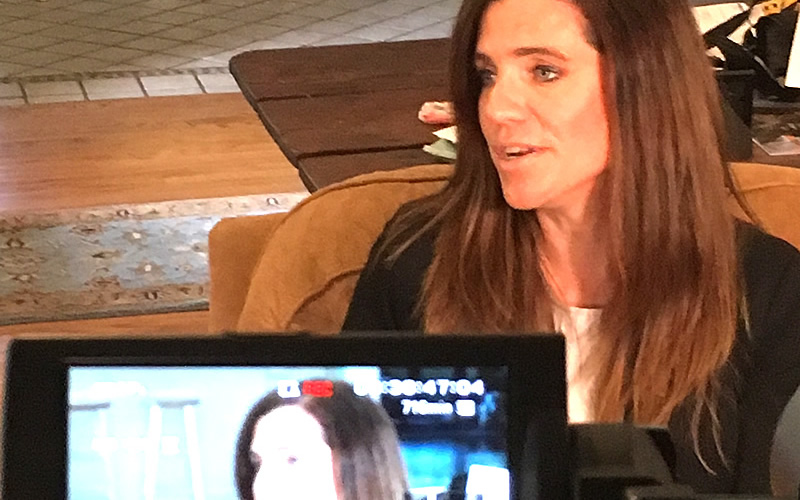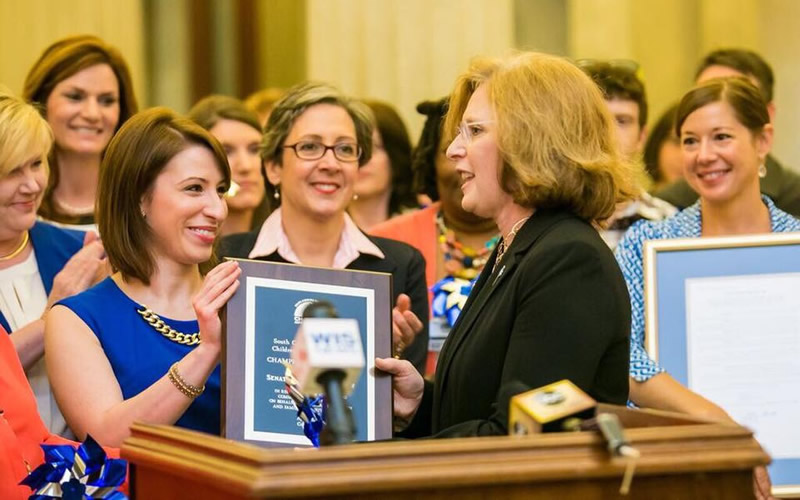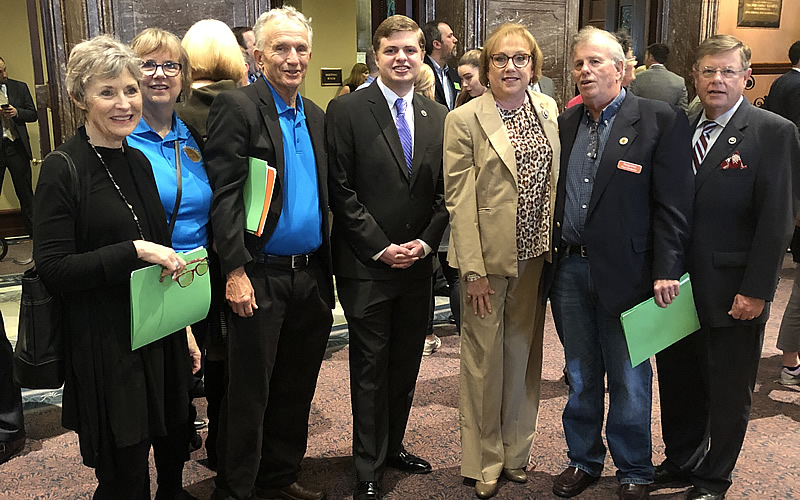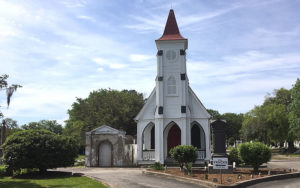 NEWS: GOP women legislators lead in big ways
NEWS: GOP women legislators lead in big ways
BRIEFS: State to begin enforcing classroom size restrictions, more
COMMENTARY, Brack: State budget shows lawmakers’ values
SPOTLIGHT: Charleston Animal Society
MY TURN, Knapp: It’s good to keep moving forward on Santee Cooper
FEEDBACK: Two agree, one doesn’t on anti-abortion commentary
MYSTERY PHOTO: Could be anywhere, but where specifically is this?
S.C. ENCYCLOPEDIA: Education in South Carolina, part 4
NEWSBIG STORY: GOP women legislators lead in big ways

By Lindsay Street, Statehouse correspondent | Navigating tricky political terrain is just another day at the Statehouse for a distinct minority in elected office: Republican women.
In red South Carolina, there are two Republican women in the S.C. Senate (4 percent of the chamber) and 11 Republican women in the S.C. House (about 9 percent of the chamber). Republican men account for 54 percent of the Senate (25 of 46 members), and 56 percent of the House (69 of 124 members).
But while the few GOP women occupy powerful positions, their voices are powerful in both chambers and on both sides of the aisle.
“While we are small in number, we are pretty remarkable,” S.C. Rep. Nancy Mace, R-Daniel Island, told Statehouse Report this week. Before being elected to office, Mace already made history as a woman: she is the first female graduate of Charleston military college The Citadel.
In recent weeks, Mace was back in the news for impassioned remarks on rape and abortion on the House floor. She successfully amended a restrictive abortion ban to make exceptions for rape and incest. The so-called “fetal heartbeat” bill that would ban abortions after six weeks passed the House, but will wait for 2020 for the Senate to consider.
Conservative women nationwide and in the state tend to act as a moderating force in elected bodies, using personal experience to sway political action, according political scientists. And women tend to exert that power most on issues typically assigned to their gender: family, children and reproductive matters.
‘A very difficult terrain’

Mace said she is proud of her “100 percent pro-life voting record.” But she said she entered the recent abortion brouhaha because she wanted the bill to be more “in line” with the mainstream Republican Party by allowing exceptions. She talked on the floor about her personal experience with rape. Later, a fellow conservative lawmaker distributed anti-abortion material that called rape a “misdeed,” which put Mace on the offensive. Rep. Josiah Magnuson of Spartanburg apologized this week to Mace.
Of the 11 Republican women in the S.C. House, seven co-sponsored the bill. Mace was not a sponsor on the bill but the only female conservative to speak about it on the floor, which caught the attention of Statehouse observers.
“They’re trying to navigate a very difficult terrain, which is be a conservative but … they understand that rape victims shouldn’t be forced to have babies they don’t want to have,” College of Charleston assistant professor of political science Claire B. Wofford said. “It looks inconsistent … but it’s a way to please some kind of diametrically opposed groups.”
Women on the right

Wofford said any perceived “liberalism” among Republican women is relative.
“They are, at least a little bit, more pro-woman than their male colleagues,” she said.
For three years, S.C. Sen. Katrina Shealy, R-Lexington, served as the Senate’s only female lawmaker. Like Mace, she has had a strong anti-abortion record but has also pushed for exceptions to be included in restrictions.
Also like Mace, Shealy is no stranger to headlines that spotlight misogyny in the state. In her first years in office, she was called “a lesser cut of meat” by a colleague (the 2015 story still makes viral rounds on social media, prompting an entry in Snopes.com). She said those people, who want to prevent abortion exceptions and disparage women, are “something else,” but not true Republicans, despite finding a home in her party.
- In January, a pro-life activist made headlines for telling a group of S.C. lawmakers that women should not be allowed to serve.
But in the same conversation with Statehouse Report, Shealy acknowledged the uphill battle Republican women have within the party.
“Republicans have always been more conservative so they thought women should be home barefoot and pregnant and baking cookies and a lesser cut of meat — we’ve been there before,” Shealy said. “(While) the Republican Party has changed because there are more women in leadership roles, they just aren’t as advanced as the Democratic Party.”
‘A natural mantle’

Shealy said Republican women — and women in general — tend to be “the voice of reason.”
“Even if it’s not just on women’s issues,” she said.
But conservative women in Columbia and nationwide tend to keep their influence to traditional female roles, College of Charleston assistant professor of political science Karyn Amira said.
“Women tend to champion issues that are more unique to women,” she said.
Republican women don’t disagree. They only chair two of the S.C. Statehouse’s 28 standing committees, and those committees are well within the traditional views of women: the House Education and Public Works Committee chaired by Rep. Rita Allison of Lyman, and the Senate Family and Veterans Affairs Committee chaired by Shealy.
- PREVIOUS COVERAGE: This year, the Senate made history when an all-female subcommittee convened.
“We sometimes are looking at (serving) through a different lens because we are mothers, we’re grandmothers, we’re sisters,” S.C. Rep. Raye Felder, R-York, said. Felder serves as vice chair of the House Education and Public Works Committee.
Amira said Mace’s personal story of rape and her push for a rape exception in the fetal heartbeat bill is “a prime example” of lawmakers using personal experience to affect decision-making. Mace said her role as “a voice of reason and compassion” is “a natural mantle for women.”
Mace has also pushed for bills reforming the state’s divorce code and domestic violence laws.
In the Senate, Shealy has become child advocate guru among her colleagues.
“I fight for what’s in my heart, which may have something to do with my gender,” Shealy said. “Because I’m a female I think more about children’s issues and women’s issues, which I think is good because we have so many men that think about other things.”
She said her male colleagues often rally behind her causes or ask her opinion on such issues. She said it often takes a woman to bring a more family-centered issue to their attention.
“It’s not that the men didn’t care about it. It just wasn’t the thing that was jumping out to them,” Shealy said.
“Women are definitely different because we get more legislation passed, women get more things done and they usually … don’t have to talk as much,” Shealy said. She added that Republican women tend to be more successful reaching across the aisle.
- Have a comment? Send to: feedback@statehousereport.com
NEWS BRIEFS
State to begin enforcing classroom size restrictions, more
![]() By Lindsay Street, Statehouse correspondent | Since the 2010 school year, South Carolina has ignored its law governing how many students that public school teachers can have in classrooms.
By Lindsay Street, Statehouse correspondent | Since the 2010 school year, South Carolina has ignored its law governing how many students that public school teachers can have in classrooms.
But after a budget compromise this week, lawmakers agreed to remove language that allowed schools to ignore state law. The section was part of a proviso added to the annual budget and essentially made classroom size unenforceable. The budget now heads to Gov. Henry McMaster’s desk for his signature. Statehouse sources said the removal of the section is not expected to be subject to veto.
S.C. Rep. Russell Ott, D-Calhoun, championed the amendment to the budget.
“This is one of the barriers towards us getting back to where we need to be,” Ott told Statehouse Report.
There are concerns that rural schools may struggle with adhering to state law, but S.C. Department of Education spokesman Ryan Brown said waivers are available and just how much of an impact is unknown.
“We are in the process of collecting current class size data so that a statewide fiscal impact can be issued,” Brown said in an email.
Ott said the benefits outweigh costs.
“It could be an increased cost to schools but it’s a cost worth bearing, quite frankly,” he said. “That is a good use of (school district) money.”
Ott said enforcing existing state law on classroom sizes will also help with transparency because schools will need to report their class sizes to their districts, and the districts will have to report that information to the state agency.
State regulations mandate that pre-kindergarten classes are capped at 20-to-1, kindergarten through third grade are capped at 30-to-1, English language arts and mathematics for fourth and fifth grades are capped at 30-to-1, and all other grades and subjects are capped at 35-to-1. Ott said the classroom caps are still too high. See the state regulations here.
In other news:
Compromise reached on Santee Cooper bids. The House and Senate agreed this week to field binding bids for the sale of or management of the state-owned utility Santee Cooper. The evaluation of bids will be made through the Department of Administration, and the agency is charged with making a report in early 2020. Read more.
Hurricane season begins June 1. Sunday begins S.C. Hurricane Preparedness Week leading up to June 1, the official date of hurricane season. Beginning Sunday, the S.C. Emergency Management Division and local emergency managers will be highlighting ways daily that residents can prepare for the 2019 Atlantic hurricane season. State officials are urging residents to download the South Carolina Emergency Manager mobile app as your official tool for emergency planning and follow the official @SCEMD accounts on Facebook, Twitter and Instagram to stay connected. Download the guide here.
Whittle confirmed as state’s first Child Advocate. During the special session this week, the S.C. Senate confirmed Department of Social Services legal counsel Amanda Whittle as the state’s first Child Advocate, a position that begins July 1, according to S.C. Sen. Katrina Shealy, R-Lexington. Whittle was nominated to the position by Gov. Henry McMaster.
CHE search recommends Monhollon. The S.C. Commission on Higher Education’s search committee Thursday recommended a Missouri higher education professional to be its new president and executive director. Dr. Rusty Monhollon, assistant commissioner of a similar agency in Missouri, was tapped to be the South Carolina commission’s new leader. The recommendation will go the CHE Board for a vote on May 31. Another finalist, Oran P. Smith, reportedly had the backing of Gov. Henry McMaster, but his candidacy ran into political hot water when past editorship of a neo-Confederate publication came to light. Past Statehouse Report commentary is here.
S.C. seafood businessman addresses U.S. Senate. Murrells Inlet Seafood founder Rick Baumann told U.S. senators this week that the federal Office of Advocacy is failing to protect water-based businesses like his. The committee was hearing testimony on the reauthorization of the SBA’s Office of Advocacy, whose mission is to represent small businesses in the development of federal regulations. Baumann said “needed regulations” are slowed down or not even considered due to the influence of “big business interests.” Read more.
Tomlin to chair state workforce development board. Gov. Henry McMaster has appointed Donald R. Tomlin, Jr. to serve as chairman of the S.C. State Workforce Development Board. Tomlin is a longtime South Carolina-based investor and entrepreneur, and most recently served as the chairman of the board of the South Carolina State Housing, Finance and Development Authority.
2020 candidate calendar
 Throughout the campaign season, we are working to keep South Carolina informed of candidate events in the state. Have an event you want us to know about? Email us at 2020news@statehousereport.com. In the coming days:
Throughout the campaign season, we are working to keep South Carolina informed of candidate events in the state. Have an event you want us to know about? Email us at 2020news@statehousereport.com. In the coming days:
- Williamson: Spiritual adviser Marianne Williamson will host town halls May 25 9:20 a.m. at Neck Community Center in Gresham and 11:15 a.m. at Sellers Community Center in Sellers. She will also deliver the keynote address at the Women of Power Conference 7 p.m. May 25 in Florence. On May 26, Williamson will attend the 10 a.m. service at Second Nazareth Baptist Church in Columbia.
- Sanders: U.S. Sen. Bernie Sanders, I-Vt., will hold a rally 7 p.m. May 25 at 199 Coker Ave. in Denmark.
- Harris: U.S. Sen. Kamala Harris, D-Calif, will hold a MSNBC town hall 10 p.m. May 28 at Wofford College in Spartanburg. On May 29, Harris will also hold an Education Town Hall 3:30 p.m. at West End Community Center in Greenville and meet and greets 11:45 a.m. at Westside Community Center in Anderson and 1:45 p.m. at a location to be announced in Greenville.
- Moulton: Congressman Seth Moulton, D-Mass., is holding veterans mental health rally 6:30 p.m. May 30 at Carolina Western Pub in Columbia.
- On TV: The Black Economic Alliance will host a presidential forum noon to 4 p.m. June 15 for some Democratic candidates at the Charleston Music Hall. Tickets required, but free. To be aired on BET.
- Hear from 18 of the Democratic candidates. On June 22, the S.C. Democratic Party will have its annual state convention. Eighteen of the 23 declared Democratic presidential hopefuls are signed up to speak. Read more.
Looking ahead
Click below for other items coming up in the Statehouse:
Find any bill
While the General Assembly isn’t in session now, there are thousands of bills still in the hopper waiting for consideration in 2020. Click the links below to search.
- Have a comment? Send to: feedback@statehousereport.com
BRACK: State budget shows lawmakers’ values

By Andy Brack, editor and publisher | There’s a lot that goes on in a legislative session: Thousands of bills are filed. Hundreds of news stories are written about those bills. Scores of committee meetings underscore why making laws is as unsightly as making sausage.
 Through it all after several months of work, much hot air was expended. Tempers flared. Filibusterers filibustered. Lobbyists lobbied. Visitors gawked. And a few laws got passed.
Through it all after several months of work, much hot air was expended. Tempers flared. Filibusterers filibustered. Lobbyists lobbied. Visitors gawked. And a few laws got passed.
In 2019, legislators agreed enough to pass 113 measures – everything from the $9 billion budget to rejiggering voting precincts in Anderson, Greenwood, Dorchester, Pickens, Abbeville and Dillon counties. In fact, they seemed to like fiddling so much with Greenwood County’s precinct maps that they did it twice, first in March and later as the session was coming to a close.
The biggest thing that happens annually in any legislative session is passage of how the state will spend the money it collects in taxes to pay for government services. Because budgets are how we prioritize what’s important, legislators essentially are monetizing core values when they approve spending legislation. As religious writer and activist Jim Wallis has written, “Any budget is a moral statement of priorities, whether it’s a budget created by an individual, a family, a school, a city or a nation. It tells us, mathematically, what areas, issues, things, or people are most important to the creators of that budget, and which are least important.”
So in the 2019-20 budget, what did legislators say was important in spending what we sent to the government? Here’s a list of how they agreed to spend new monies, including a $1 billion surplus:
Employee pay. Current public school teachers will get a 4 percent pay hike and new teachers will start at $35,000 a year, up $3,000. Total cost: $159 million. (Teachers also will get a 2 percent boost that all state employees get ($41 million total), plus a recurring increase for health cost increases that will cost another $50 million.) The state also added $32 million to its contribution to underfunded state pensions.
Schools. Lawmakers hiked the base student cost slightly, but still are underfunding public education by millions of dollars based on a funding formula. An extra $10 million will go to pay for police in school districts that can’t afford them. Another $19 million went to school bus purchases from the lottery.
Higher education. An extra $44 million will go to state public colleges and universities, with a provision that limits higher tuition for in-state students. Additionally, the legislature added $112 million for long-deferred capital needs at college buildings. In the past, there was talk of using borrowed funds for bonding to deal with billions in needs from colleges.
Equipment. The state set aside $40 million to buy new voting machines to replace the dinosaurs now being used. Lawmakers finally agreed to spend $29 million on a child support enforcement computer system, something long required by the federal government. (We’re the only state without the right system and have wasted lots of money and time trying to get it on the cheap.)
Gimmick. Lawmakers agreed to send $50 to each taxpayer who files a tax return. Cost: $67 million. Impact per household: $4 per month. Spin: It’s nothing more than a political bribe to make you think you’re getting something when you probably won’t feel it at all.
Reserves. Lawmakers fully funded state reserve funds, adding $37 million to rainy-day pots that now total $569 million. With summer weather getting more erratic and a trade war impacting the economy, it’s wise to keep reserves topped up in case something unexpected happens.
So what does all of this spending tell us? Mostly, it shows the state is finally ponying up for long ignored needs — everything from schools to buildings to things we should have done a long time ago. Thank goodness there was a surplus this year to help jumpstart the state.
Now it’s time for tough discussions to pass real and comprehensive tax reform so that we can keep up with existing needs – and not get behind the eight ball again so that we have to wait a generation before doing what we should have done in the first place.
- Andy Brack’s new book, “We Can Do Better, South Carolina,” is now available in paperback via Amazon.
- Have a comment? Send to: feedback@statehousereport.com.
SPOTLIGHT: Charleston Animal Society
 We’re pleased today to shine our spotlight on the Charleston Animal Society, leader in the effort to make Charleston County a safe place for animals. Now the society is working to expand its Charleston success statewide to energize the state to reshape its 300-plus shelters and animal organizations into a no-kill network that stretches from Walhalla to Little River to Daufuskie Island.
We’re pleased today to shine our spotlight on the Charleston Animal Society, leader in the effort to make Charleston County a safe place for animals. Now the society is working to expand its Charleston success statewide to energize the state to reshape its 300-plus shelters and animal organizations into a no-kill network that stretches from Walhalla to Little River to Daufuskie Island.
Safe and healthy communities, neighborhoods and families don’t just happen – they’re built. “No Kill – No Harm – No More” shines a spotlight on animal abuse and family violence, which are often perceived and treated as separate issues. However, animal abuse is often the tip of the iceberg to larger issues in the home, such as child abuse, elder abuse or domestic violence.
- South Carolina’s most honored charity four years in a row
- National model for success
- Southeast’s only AAHA-accredited combined clinic and shelter
- Focused on solving problems rather than reacting to them year after year
- Publishes Carolina Tails, the largest pet magazine in S.C.
- No Kill. No Harm. No More. is a “movement” comprised of two major initiatives: No Kill Charleston and No Kill South Carolina.
- Learn moreabout the Charleston Animal Society and its work to create a network of humane network for the animals that bring joy to our lives.
KNAPP: It’s good to keep moving forward on Santee Cooper

By Frank Knapp, special to Statehouse Report | Three months ago, the South Carolina Small Business Chamber of Commerce (SCSBCC) began advocating for the sale of the state utility, Santee Cooper, if our organization’s goals to save consumers money and protect the environment could be achieved.

First, we do not want the Santee Cooper direct ratepayers or customers of the state’s 20 electric cooperatives, which purchase most of their energy from the utility, to pay for any of the $4 billion in nuclear debt Santee Cooper had racked up from the failed nuclear construction project in Fairfield County.
This was the same position SCSBCC held regarding SCE&G’s $5 billion of construction debt for the same failed project. We didn’t want customers to pay for any of that debt either.
The SCE&G financial crisis was largely resolved when Dominion Energy of Virginia was approved by the state to buy the utility and agreed not to charge customers for about half of the nuclear debt. This wasn’t everything we wanted, but the utility’s customers did receive a 15 percent reduction in their electric rates.
Now we believe that the state can get a better deal for the Santee Cooper customers.
Not only do we want a sale to remove the $4 billion of nuclear debt from the backs of the utility’s customers, but we also hope that ratepayers will also never have to pay another $3.2 billion of Santee Cooper’s debt it has accumulated.
Non-binding proposals from for-profit utilities have already been made to the state that indicate this financial goal can be achieved.
 Our second goal is for any purchase to include quick retirement of Santee Cooper’s costly, dirty coal plants by transitioning to renewable energy and natural gas generation. Reducing carbon pollution that is driving climate change resulting in rising seas and flooding has been a top priority for the SCSBCC.
Our second goal is for any purchase to include quick retirement of Santee Cooper’s costly, dirty coal plants by transitioning to renewable energy and natural gas generation. Reducing carbon pollution that is driving climate change resulting in rising seas and flooding has been a top priority for the SCSBCC.
We held six town halls across the state to engage the public on this issue. Many Santee Cooper supporters attended, and the vigorous conversations always ended with a mutual agreement that the legislature should establish a thorough process for reviewing proposals from private companies to either purchase or manage the utility. And to be fair, Santee Cooper should be given the opportunity to say how it would change to address critics’ concerns.
This week the S.C. General Assembly approved just such a plan.
The legislature passed a joint resolution that sets in motion a process to determine if the heavily in-debt Santee Cooper should be sold or managed by a private utility or kept as a reformed state agency.
The S.C. Department of Administration will accept offers to either purchase or manage Santee Cooper, evaluate the offers and make a recommendation to the legislature by Jan. 15, 2020, as to the best purchase and management offers. A recommendation on Santee Cooper’s own proposal to remain a state agency will also be made.
We applaud our state legislators for establishing a merit-based, fair process to determine what is in the best interest of the State, taxpayers and Santee Cooper customers.
We continue to believe that neither a contract to manage Santee Cooper nor simply reforming the agency will accomplish our goals of $7.2 billion in financial relief for customers and dramatically reducing the utility’s carbon emissions.
These two matters will be part of the criteria the Department of Administration will use in making its recommendation to the General Assembly. Other criteria will include projected future rates, the impact on current employees and the issue of the water systems operated by Santee Cooper.
While we would have preferred the legislature to have made a final decision on Santee Cooper before the end of this year, the General Assembly should be congratulated for taking on the arduous task of debating and evaluating this controversial issue and then setting the process for its resolution.
Knapp is the president and CEO of the South Carolina Small Business Chamber of Commerce.
- Have a comment? Send to: feedback@statehousereport.com.
FEEDBACK
Yes, we should do better
To the editor:
![]() I agree that there is much in South Carolina [that] we can and SHOULD DO BETTER. I do not know the answers and have problems with understanding the questions.
I agree that there is much in South Carolina [that] we can and SHOULD DO BETTER. I do not know the answers and have problems with understanding the questions.
As with too many problems/opportunities, there are very few “right answers” and “black or white” solutions, especially on abortion. Too many want to save babies and kill adults. Too many want government control for what they want , but not for what they do not want. Too many perhaps even YOU and me want it both ways and “talk out of both sides of our mouth.”
It may appear to some that too many say,” Respect me and my thoughts but also respect my not treating you as I think I should be treated.” Some may think if they throw enough mud on the wall, some may stick.
How can these allegedly racist zealots be against “welfare mothers” and abortion?
Sometimes one must fight for peace. Too much saying nothing … let’s try to move forward in a positive process.
— Ed Davis, Florence
Rejects argument on abortion
To the editor:
For a guy who I suspect is likable, I sure find myself disagreeing with you a lot.
Frankly, I reject the way you frame the argument. This is more a matter of a group of people looking at circumstances where unborn but living human beings are being murdered in the womb as a matter of convenience once the mother and father have to face the consequences of their lack of personal responsibility. The question is “When do those children (millions of them now gone) receive their right to life?”
Interestingly, you forgot to mention that Governor Wallace in the file photo you used was a Democrat, as were nearly all of the segregationists and KKK members of the Deep South. It was conservative Republicans, starting with Lincoln, who stood up for the rights of first slaves and then later poor blacks.
Johnson’s Great Society tricked the nation’s black population into believing that those same Democrats were now really sorry about what they’d done, and that now all the black folks had to do was vote D and all their troubles would go away. Suddenly, fathers could abandon their responsibilities and the $ kept coming in. Then Roe v. Wade comes along and POOF!, who needs to be responsible for their bodies? The result has been a trail of body parts (hey, maybe we can sell those) and the souls of countless children, most of them black.
When it’s a matter of when that mass of tissue becomes a person, I choose to cautiously err on the side of life.
— Phil Tackett, Summerville, S.C.
Great detector
To the editor:
You have a wonderful crap detector to see through the motives of the conservative zealots/anti-abortion crowd.
Rural women, especially those of color, are being targeted again by the same mentality of the old white male Southern planters.
— Milton Marley, Ridgeway, S.C.
Send us your thoughts … or rants
We love hearing from our readers and encourage you to share your opinions. But you’ve got to provide us with contact information so we can verify your letters. Letters to the editor are published weekly. We reserve the right to edit for length and clarity. Comments are limited to 250 words or less. Please include your name and contact information.
- Send your letters or comments to: feedback@statehousereport.com
Could be anywhere, but where specifically is this?

This building might look familiar to some readers in the Lowcountry. What and where is it? (Note: We blurred part of it to make it a little harder to identify.) Send your guess about the location of this photo to feedback@statehousereport.com. And don’t forget to include your name and the town in which you live.
Our previous Mystery Photo
 The subject of our May 17 mystery, “Tall, narrow building,” seemed to stump many readers, based on the fewer-than-normal responses we got. It shows a chapel in Bethany Cemetery, a Lutheran site near Charleston’s Magnolia Cemetery. The chapel now apparently is used as office space, while a former receiving tomb is a storage space, we hear.
The subject of our May 17 mystery, “Tall, narrow building,” seemed to stump many readers, based on the fewer-than-normal responses we got. It shows a chapel in Bethany Cemetery, a Lutheran site near Charleston’s Magnolia Cemetery. The chapel now apparently is used as office space, while a former receiving tomb is a storage space, we hear.
Congratulations to alert Virginia readers who identified the photo: George Graf of Palmyra, Va.; and Dale Rhodes of Richmond, Va. A hat tip to Frank Bouknight of Summerville and Judy Hines of Charleston for getting it almost right by guessing Magnolia Cemetery.
Also thanks to Graf for this detail about the cemetery: “According to Adventures in Cemetery Hopping, St. Matthew’s Lutheran Church opened Bethany Cemetery in 1856 after its first cemetery (Hampstedt Cemetery) on Reid Street was filled after several yellow fever outbreaks devastated Charleston’s immigrant German population. In the 1930s, the property Hampstedt Cemetery was located on was sold at auction and divided into lots when assessments for a street paving project weren’t paid.
“Lo and behold, the Charleston Housing Authority discovered human remains on the property in 1981 whilst preparing to build on it. How they didn’t know seems a bit farfetched but nevertheless, close to 500 of those graves were moved to Bethany Cemetery in 2009. What was a chapel at one time is now the cemetery office. It is not in the best condition, nor is the receiving tomb beside it. The receiving tomb is now used as a maintenance building to store equipment, it appears. These are mostly found in the North because snow/ice would freeze the ground, causing delays in burial. South Carolina doesn’t have that problem. But my guess is that like Atlanta’s Westview, sometimes they had long stretches of rain and burials had to be delayed due to muddy conditions. They had to store the bodies somewhere.”
- Send us a mystery: If you have a photo that you believe will stump readers, send it along (but make sure to tell us what it is because it may stump us too!) Send to: feedback@statehousereport.com and mark it as a photo submission. Thanks.
S.C. ENCYCLOPEDIA
HISTORY: Education in South Carolina

S.C. Encyclopedia, part 4 of 4 | The South Carolina Education Improvement Act (EIA) in 1984 and the 1989 Target 2000: School Reform for the Next Decade were comprehensive public school reform packages that brought South Carolina into the mainstream of educational reform.
Funds were allocated for half-day child-development programs, kindergarten for all five-year-olds, special programs for gifted and talented students, and remedial programs for those children who did not pass the basic skills exam. Higher-order thinking skills were required to be included in the school curricula, as well as discipline-based art, music, dance, and drama. Requirements for graduation increased, and dropout- prevention programs were funded. Schools, teachers, and principals were offered monetary bonuses for good test scores.
The EIA represented the largest increase in school funding per child in the country. On the other hand, hundreds of South Carolina teachers (most of them African American) were slated to lose their jobs because they were not meeting the standards set by the EIA, and African American students made up a disproportionate number of those failing the exit exam. By 1989 the state’s graduation rate had risen three percent, and although South Carolina continued to rank last in SAT scores, the state’s average had the largest increase of any state in six years.
During the 1990s a series of laws addressed specific school issues. The primary purpose of the Early Childhood Development and Academic Assistance Act of 1993 was to place emphasis on early childhood education and remediation in the elementary grades. It promoted developmentally appropriate curricula and parenting/family literacy.
The 1994 School-to-Work Transition Act clarified the connection between school and the workplace by abolishing the “general track,” which did not prepare students for either technical vocations or college, and requiring that all students be placed in either a “tech prep” or “college prep” curriculum. These curricula were to provide rigorous preparation in marketable occupational and academic skills.
The Charter School Act of 1996 was intended to provide an opportunity for flexible, innovative, and substantially deregulated public schools. Competition with these schools was seen as a healthy stimulant for change and improvement.
The South Carolina Education Accountability Act (EAA) of 1998 created a performance-based accountability system by setting grade-level standards, requiring district and school report cards to be published in newspapers beginning in 2001, and creating an over- sight committee to monitor and evaluate the implementation of the act. School-readiness tests, grade-level academic standards, and standard-based assessments were required, with academic plans for each child who did not perform at grade level.
The Palmetto Achievement Challenge Tests (PACT) were developed in-state as the standards-based assessment tool, replacing the BSAP. The first PACT testing in 1999 indicated that a third of South Carolina’s elementary- and middle-school students were not prepared to enter the next grade level. To enable the state to compare its students with others across the country, Terra Nova, a nationally standardized test, replaced the Stanford 8 (used 1990–1994) and the Metropolitan Achievement Test 7 (used 1995–1998). Terra Nova was administered to around thirteen percent of students in grades three, six, and nine for the first time in April 1999.
The end of the century saw two more education acts, the First Steps to School Readiness Act of 1999 and the Parental Involvement in Their Children’s Education Act of 2000. First Steps was intended to ensure that children arrived at first grade healthy and ready to learn. Its goals included supporting parents in optimizing their children’s development through access to health care, nutrition, and preschool programs.
The Parental Involvement Act was intended to heighten parental awareness of the importance of their role in the development and education of their children. Schools were challenged to become more “parent friendly.” Both acts reflected the state’s awareness and adoption of contemporary educational research and its implications for schooling. While years of neglect cannot be remedied overnight, the state is clearly expending great efforts to foster effective twenty-first-century schools.
— Excerpted from an entry by Deborah M. Switzer and Robert P. Green Jr. This entry may not have been updated since 2006. To read more about this or 2,000 other entries about South Carolina, check out The South Carolina Encyclopedia, published in 2006 by USC Press. (Information used by permission.)
Now available in paperbrack, err, paperback
 Now you can get a copy of editor and publisher Andy Brack’s We Can Do Better, South Carolina! ($14.99) as a paperback.
Now you can get a copy of editor and publisher Andy Brack’s We Can Do Better, South Carolina! ($14.99) as a paperback.
The book of essays offers incisive commentaries by editor and publisher Andy Brack on the American South, the common good and interesting South Carolina leaders, such as former U.S. Sen. Fritz Hollings, civil rights advocate Septima Clark, former S.C. Gov. David Beasley and more. There also are discussions on civil rights struggles with which the Palmetto State continues to grapple. as well as commentaries on politics, governments, the hangovers of South Carolina’s past and her future opportunities.
We Can Do Better, South Carolina! is also available exclusively as a Kindle book for $7.99. Click here to purchase a Kindle copy.
- If you have a comment or questions about the book, please let us know at: feedback@statehousereport.com.
ABOUT STATEHOUSE REPORT
Statehouse Report, founded in 2001 as a weekly legislative forecast that informs readers about what is going to happen in South Carolina politics and policy, is provided to you at no charge every Friday.
Meet our team
- Editor and publisher: Andy Brack, 843.670.3996
- Statehouse correspondent: Lindsay Street
More
- Mailing address: Send inquiries by mail to: P.O. Box 22261, Charleston, SC 29407
- Subscriptions are free: Click to subscribe.
- We hope you’ll keep receiving the great news and information from Statehouse Report, but if you need to unsubscribe, go to the bottom of the weekly email issue and follow the instructions.
- © 2019, Statehouse Report. All rights reserved.















